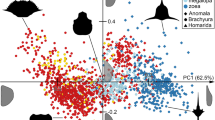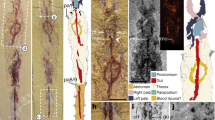Abstract
KING crabs (Family Lithodidae) are among the world's largest arthropods, having a crab-like morphology and a strongly calcified exoskeleton1–6. The hermit crabs, by contrast, have depended on gastropod shells for protection for over 150 million years5,7. Shell-living has constrained the morphological evolution of hermit crabs by requiring a decalcified asymmetrical abdomen capable of coiling into gastropod shells and by preventing crabs from growing past the size of the largest available shells1–6. Whereas reduction in shell-living and acquisition of a crab-like morphology (carcinization) has taken place independently in several hermit crab lineages, and most dramatically in king crabs1–6, the rate at which this process has occurred was entirely unknown2,7. We present molecular evidence that king crabs are not only descended from hermit crabs, but are nested within the hermit crab genus Pagurus. We estimate that loss of the shell-living habit and the complete carcinization of king crabs has taken between 13 and 25 million years.
This is a preview of subscription content, access via your institution
Access options
Subscribe to this journal
Receive 51 print issues and online access
$199.00 per year
only $3.90 per issue
Buy this article
- Purchase on Springer Link
- Instant access to full article PDF
Prices may be subject to local taxes which are calculated during checkout
Similar content being viewed by others
References
Borradaile, L. A. Nat. Hist. Rep. Zool. 3, 111–126 (1916).
Wolff, T. Galthea Rep. 4, 11–32 (1961).
Stevcic, Z. Syst. Zool. 20, 331–349 (1971).
McLaughlin, P. A. J. crust. Biol. 3, 608–621 (1983).
Vermeij, G. J. Evolution and Escalation (Princeton University Press, NJ, 1987).
Blackstone, N. W. J. Zool., Lond. 217, 477–490 (1989).
Glaessner, M. F. in Treatise on Invertebrate Paleontology (ed. Moore, R. C.) Arthropods 4 R400–R651 (Geol. Soc. Amer., and Univ. Kansas Press, 1969).
MacDonald, J. M., Pike, R. B. & Williamson, D. I. Proc. zool. Soc., Lond. 128, 209–257 (1957).
Pike, R. B. & Williamson, D. I. Pubbl. Sta. Zool. Napoli 3, 493–552 (1960).
Martin, J. W. & Abele, L. G. J. crust. Biol. 6, 576–616 (1986).
McLaughlin, P. A. Zool. Verhand. 130, 1–396 (1974).
Cunningham, C. W., Buss, L. W. & Anderson, C. Evolution 46, 1301–1308 (1991).
Williams, A. B. Shrimps, Lobsters, and Crabs of the Atlantic Coast of the United States, Maine to Florida (Smithsonian Institution, Washington, DC, 1984).
Martin, A. P., Kessing, B. D. & Palumbi, S. R. Molec. Biol. Evol. 7, 485–488 (1990).
Reese, E. S. Science 161, 385–386 (1968).
Alberch, P., Gould, S. J., Oster, G. F. & Wake, D. B. Paleobiology 5, 296–317 (1979).
Blackstone, N. W. Bio. Bull. 171, 379–387 (1986).
Blackstone, N. W. thesis, Yale Univ. (1985).
Higgins, D. G. & Sharp, P. M. CABIOS 5, 151–153 (1989).
Hart, J. L. F. Crabs and their Relatives in British Columbia (British Columbia Provincial Museum, 1982).
Saiki, R. K. et al. Science 239, 487–491 (1988).
Palumbi, S. R. et al. The Simple Fool's Guide to PCR, Version 2.0 (University of Hawaii Zoology Department, Honolulu, 1991).
Sanger, F., Nicklen, S. & Coulson, A. R. Proc. natn. Acad. Sci. U.S.A. 74, 5463–5467 (1977).
Swofford, D. L. PAUP Version 3.0q (Illinois Natural History Survey, Champagne, 1991).
Felsenstein, J. PHYLIP Manual Version 3.3 (Herbarium, University of California, Berkeley, 1990).
Kishino, H. & Hasegawa, M. J. molec. Evol. 29, 170–179 (1989).
Hillis, D. M. & Moritz, C. in Molecular Systematics (eds Hillis, D. M. & Moritz, C.) 502–510 (Sinauer Associates, Sunderland, Massachusetts, 1990).
Kafanov, A. I. Can. Transl. Fish aquat. Sci. 5052, 1–77 (1984).
Vermeij, G. J. Science 253, 1099–1104 (1991).
Author information
Authors and Affiliations
Rights and permissions
About this article
Cite this article
Cunningham, C., Blackstone, N. & Buss, L. Evolution of king crabs from hermit crab ancestors. Nature 355, 539–542 (1992). https://doi.org/10.1038/355539a0
Received:
Accepted:
Issue Date:
DOI: https://doi.org/10.1038/355539a0
This article is cited by
-
The Chinese mitten crab genome provides insights into adaptive plasticity and developmental regulation
Nature Communications (2021)
-
Transcriptome profiling and in silico detection of the antimicrobial peptides of red king crab Paralithodes camtschaticus
Scientific Reports (2020)
-
Molecular and Systematic Identification of Food Marine Shrimps Using mtCOI Marker from Southeast Coast of India
Thalassas: An International Journal of Marine Sciences (2020)
-
Comparative mitogenomics of the Decapoda reveals evolutionary heterogeneity in architecture and composition
Scientific Reports (2019)
-
Evolution through cold and deep waters: the molecular phylogeny of the Lithodidae (Crustacea: Decapoda)
The Science of Nature (2018)
Comments
By submitting a comment you agree to abide by our Terms and Community Guidelines. If you find something abusive or that does not comply with our terms or guidelines please flag it as inappropriate.



